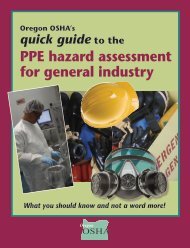Technical Manual - Section 3 (Safety Hazards)
Technical Manual - Section 3 (Safety Hazards)
Technical Manual - Section 3 (Safety Hazards)
Create successful ePaper yourself
Turn your PDF publications into a flip-book with our unique Google optimized e-Paper software.
and boilers can leave deposits of vanadium oxide and nickel<br />
oxide in furnace boxes, ducts, and tubes. It is also desirable<br />
to remove trace amounts of arsenic, vanadium, and nickel<br />
prior to processing as they can poison certain catalysts.<br />
SALTS<br />
Crude oils often contain inorganic salts such as sodium<br />
chloride, magnesium chloride, and calcium chloride in<br />
suspension or dissolved in entrained water (brine). These salts<br />
must be removed or neutralized before processing to prevent<br />
catalyst poisoning, equipment corrosion, and fouling. Salt<br />
corrosion is caused by the hydrolysis of some metal chlorides<br />
to hydrogen chloride (HCl) and the subsequent formation of<br />
hydrochloric acid when crude is heated. Hydrogen chloride<br />
may also combine with ammonia to form ammonium chloride<br />
(NH 4 Cl), which causes fouling and corrosion.<br />
CARBON DIOXIDE<br />
Carbon dioxide may result from the decomposition of<br />
bicarbonates present in or added to crude, or from steam used<br />
in the distillation process.<br />
NAPHTHENIC ACIDS<br />
Some crude oils contain naphthenic (organic) acids, which<br />
may become corrosive at temperatures above 450 o F when the<br />
acid value of the crude is above a certain level.<br />
MAJOR REFINERY PRODUCTS<br />
GASOLINE<br />
The most important refinery product is motor gasoline, a<br />
blend of hydrocarbons with boiling ranges from ambient<br />
temperatures to about 400 o F. The important qualities for<br />
gasoline are octane number (antiknock), volatility (starting<br />
and vapor lock), and vapor pressure (environmental control).<br />
Additives are often used to enhance performance and provide<br />
protection against oxidation and rust formation.<br />
KERSONE<br />
Kerosene is a refined middle-distillate petroleum product that<br />
finds considerable use as a jet fuel and around the world in<br />
cooking and space heating. When used as a jet fuel, some of<br />
the critical qualities are freeze point, flash point, and smoke<br />
point. Commercial jet fuel has a boiling range of about<br />
375-525º F, and military jet fuel 130-550º F. Kerosene, with<br />
less-critical specifications, is used for lighting, heating,<br />
solvents, and blending into diesel fuel.<br />
LIQUEFIED PETROLEUM GAS (LPG)<br />
LPG, which consists principally of propane and butane, is<br />
produced for use as fuel and is an intermediate material in the<br />
manufacture of petrochemicals. The important specifications<br />
for proper performance include vapor pressure and control of<br />
contaminants.<br />
DISTILLATE FUELS<br />
Diesel fuels and domestic heating oils have boiling ranges of<br />
about 400-700º F. The desirable qualities required for<br />
distillate fuels include controlled flash and pour points, clean<br />
burning, no deposit formation in storage tanks, and a proper<br />
diesel fuel cetane rating for good starting and combustion.<br />
RESIDUAL FUELS<br />
Many marine vessels, power plants, commercial buildings<br />
and industrial facilities use residual fuels or combinations of<br />
residual and distillate fuels for heating and processing. The<br />
two most critical specifications of residual fuels are viscosity<br />
and low sulfur content for environmental control.<br />
COKE AND ASPHALT<br />
Coke is almost pure carbon with a variety of uses from<br />
electrodes to charcoal briquets. Asphalt, used for roads and<br />
roofing materials, must be inert to most chemicals and<br />
weather conditions.<br />
III:2-9
















